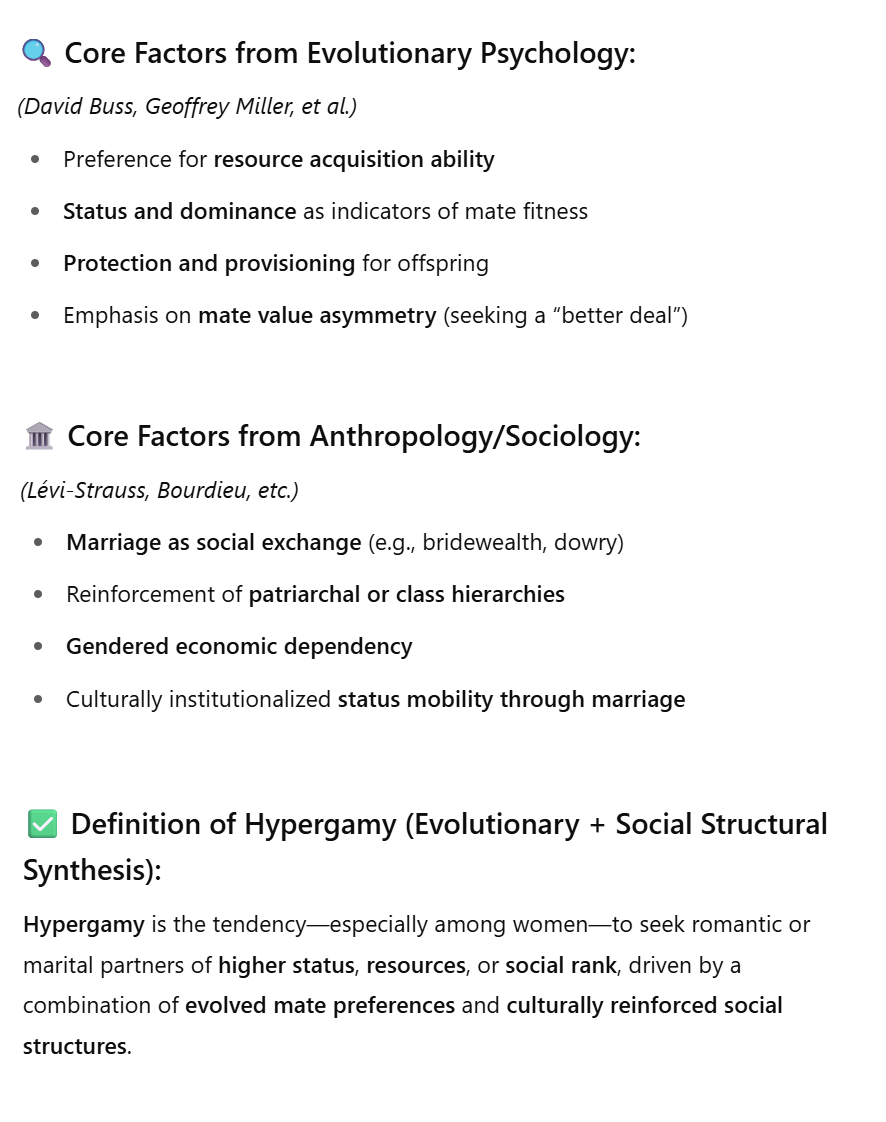______________________
SOURCES:
1. Evolutionary Psychology (Biological/Evolutionary Model)
Defines hypergamy as a female mating preference for partners of higher status, resources, or genetic quality, shaped by evolutionary pressures.
Key Sources:
-
David M. Buss (1989). Sex differences in human mate preferences: Evolutionary hypotheses tested in 37 cultures.
A landmark cross-cultural study showing women consistently prioritize status and resource acquisition in mates.
-
Buss, D. M. (2015). Evolutionary Psychology: The New Science of the Mind.
Comprehensive textbook with a section on hypergamous preferences as reproductive strategies.
-
Geoffrey Miller (2000). The Mating Mind.
Explores how mate choice—including hypergamy—shapes intelligence and creativity evolutionarily.
2. Anthropology & Sociology (Social Structural Model)
Explores hypergamy as a socially constructed pattern related to marriage systems, gender roles, and power dynamics—often reinforced by tradition or patriarchy.
Key Sources:
-
Claude Lévi-Strauss (1949). The Elementary Structures of Kinship.
Discusses bride exchange and status hierarchy in kinship systems; early use of hypergamy in marriage structures.
-
Sylvia Yanagisako & Jane Collier (1987). Gender and Kinship: Essays Toward a Unified Analysis.
Frames hypergamy as a tool of gendered social reproduction within patriarchal systems.
-
Pierre Bourdieu (1998). Practical Reason: On the Theory of Action.
Describes how cultural capital and marriage reproduce class inequality—relevant to hypergamy.
*Text version of the above synthetic definition:
Definition of Hypergamy (Evolutionary + Social Structural Synthesis):
Hypergamy is the tendency—especially among women—to seek romantic or marital partners of higher status, resources, or social rank, driven by a combination of evolved mate preferences and culturally reinforced social structures.
_______________________________________________
ADDENDUM by OPEN AI
Scientific & Logical Weaknesses of
“Evolved Female Hypergamy” Theory
1. Male and Female Mating Preferences Are Both Contextual
-
Evolution favors flexible mating strategies in both sexes depending on environment, not fixed sex-specific instincts.
-
Women and men both show strategic variety — seeking mates for status, companionship, sex, or care depending on life stage, local ecology, and cultural expectations.
2. Cross-Cultural Data Shows Wide Variation
-
In many societies, hypergamy is weak or absent. Some women are economic providers, and status-matching or even hypogamy (marrying down) is common.
-
Cross-cultural research by anthropologists (e.g., Marlowe, Hewlett, Hrdy) shows that social roles—not biology—can determine mate preferences.
3. Neuropsychological Claims Are Inconsistent
-
Claims about women’s brains being “wired” for status-seeking are often based on unreplicated or low-validity studies.
-
Human behavior is not hardwired; neural plasticity and social learning play a dominant role.
4. Misuse of Sexual Selection Theory
-
Darwinian sexual selection does not require that females are choosy only for status or provisioning.
-
In humans, pair bonding, cooperation, and shared parental investment are central to reproductive success — not just resource extraction.
5. Hypergamy Often Reflects Structural Inequality, Not Evolution
-
For much of history, women lacked access to education, wealth, or autonomy. “Marrying up” can be explained as a survival strategy, not an evolved preference.
-
Where legal and economic equality improves, female hypergamy declines — suggesting it is not biologically ingrained.
6. Men Also Exhibit Hypergamy, Just in Other Domains
-
Men also often ‘marry up’—whether by pursuing partners with substantial dowries or by seeking youth, beauty, fertility, or social capital—forms of sexual hypergamy that reflect different but equally strategic mate preferences.
-
Both sexes selectively value traits depending on goals — men are not uniquely “non-hypergamous.”
7. Research Bias and Ecological Invalidity
-
Many hypergamy claims come from WEIRD (Western, Educated, Industrialized, Rich, Democratic) samples, especially using speed-dating or hypothetical surveys that don’t translate to real-world decisions.
-
Lab-based designs often fail ecological validity — e.g., real mate choice differs drastically from survey answers.
8. Conflates Mate Preference With Actual Behavior
-
Studies often overstate the importance of stated preferences — real-world behavior is constrained by opportunity, emotion, context, and mutual attraction.
-
E.g., a woman may say she prefers high-earning men but choose a lower-earning partner for emotional compatibility, shared values, or long-term support.
9. Poor Fit With Evolutionary Models of Cooperative Breeding
-
Human evolution involved cooperative childrearing, not just paternal provisioning.
-
Mothers, kin, and group members played key roles, making exclusive dependence on high-status males evolutionarily inefficient.
10. Cultural Myths Reinforced as Biology
-
“Hypergamy” often reflects modern gender ideologies — not evolutionary science.
-
Using it as a “biological truth” fuels sexist narratives that justify inequality and oversimplify men’s and women’s behavior.
Conclusion
The idea that women evolved to be universally or innately hypergamous is:
-
Empirically unsupported when examined across cultures and contexts.
-
Conceptually flawed because it ignores the social, ecological, and cooperative nature of human evolution.
-
Biased in application, reinforcing outdated gender stereotypes rather than advancing scientific understanding.
